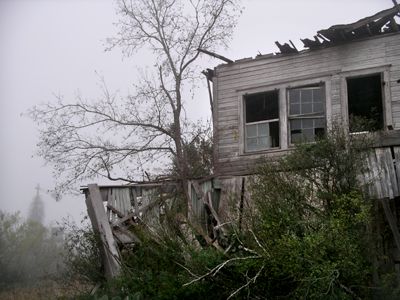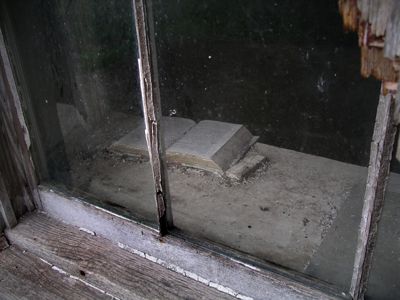
Visiting a ruined building is often a fascinating adventure. The familiar becomes alien when it is in a condition that we rarely experience. In a remarkably short time, a typical residence can transform into a unique sculptural edifice, with unexpected bits missing, sagging or tumbled about each other. Investigating the rubble of a once sheltering house is not just an engaging intellectual exercise; it is an emotional voyage. The realization that some barren, neglected dwelling was built, cared for, and lived in, is possibly one of the most dramatic juxtapositions a human can examine.
I've not explored nearly enough old structures to satisfy my curiosity. While they exist all around us, gaining access is not always a foregone conclusion. One place I saw when I was about 11 years old was right next door. An old ramshackle house on the lot behind ours had been the home for a family that obviously had very little money. The kids attended school with us, but were awkward, wore obviously ragged clothes and never seemed to fit in very well. They moved out very suddenly, overnight actually. After awhile, it was obvious that the place was deserted, so we satisfied our curiosity and had a look around. The door was not locked, and was, in fact, not even closed. It no longer fit into its frame. Standing in one room, I could see daylight between the top of the wall and the ceiling. The whole place was falling apart. Wall paper was peeling, curtains were torn, there were holes in walls, debris lay all about, and everything smelled musty. It looked like it had been empty for years, and so it was amazing to me that up until a few days before, a whole family had lived there. Within a month, it had been torn down and construction began on a new house.
One thing I have noticed is that stone walls hold up much better than wood. No big surprise, really. There is a kind of dilapidated dignity to brick chimneys, stone columns and cement buttresses, akin to remnants of castles, forts or cathedrals, but wood-framed houses descend into pathetic chaos with no sense of decorum. It is uncanny how quickly unmaintained wooden structures rot away. In just a few years it is as if they have melted or been absorbed into the landscape. I am reminded of the differences between the majestic brick parapets of a forsaken mansion on Cumberland Island, GA, and a derelict wooden farmhouse just outside of Austin, TX.
The island estate had belonged to a wealthy family and had been left permanently vacant because the property became a national park. In spite of the harsh coastal climate, the well-constructed masonry was only gradually eroding away. Chimneys and outer walls still towered above the overgrown gardens and lawn. Iron gates remained on their hinges and impenetrable metal grills secured low windows against intruders. Of course, the roofs and most of the wooden trim were gone, but the stately walls retained their noble character.
Although the frame house in Texas had been vacant for a shorter period, it had no durable stone sections, and the only part that still stood straight was the brick chimney. It's reason for becoming obsolete was simply that a more modern home replaced it on the large property. Instead of a sense of substantial history, the falling structure evoked a more gloomy sensation, like that of a toy simply outgrown and tossed in the rubbish.
 Whatever the background story, the setting, or the state of disrepair, there is a strange magnetism about abandoned buildings. Maybe it's the same sort of morbid curiosity that draws one to look at a corpse, automobile wreck or burning building. Or maybe there is a kind of visual poetry in the play of light across dusty surfaces and broken beams. The odd, sort of cinematic backdrop to an imagined story that is now lost can inspire poignant, enigmatic or disquieting ideas.
Whatever the background story, the setting, or the state of disrepair, there is a strange magnetism about abandoned buildings. Maybe it's the same sort of morbid curiosity that draws one to look at a corpse, automobile wreck or burning building. Or maybe there is a kind of visual poetry in the play of light across dusty surfaces and broken beams. The odd, sort of cinematic backdrop to an imagined story that is now lost can inspire poignant, enigmatic or disquieting ideas.
Even if the location is unfamiliar and past inhabitants are nameless, encountering a staircase leading to nowhere, a bathroom sink sticking out of a second story floorless corner, or a door that opens to a wall of debris covered in vines can be as startling as the final chapter of a really first-rate mystery novel. Then there are the little details: a pile of silverware on a countertop, a doll lying under a rocking chair, a water glass perched on a window sill, a comb on a clothes chest, or an open book on an otherwise bare table. One cannot help but speculate on the narratives behind each item and what caused them to be left behind. With or without additional personal items, it is impossible to not compare the eerie surroundings with the very similar situations in which we spend a good portion of every day. We work very diligently to create and maintain the structures of our lives, including our most intimate spaces, which are the homes in which we live.
Really old houses, sheds and barns are less disconcerting than equally decrepit modern equivalents. Distance in time equals a loss in empathy, so we are more likely to just observe and not ponder when it comes to a 150 year old abode. But a ruined home only a few decades old, with modern plumbing, fixtures, tiles and curtains gives more of an impression of disaster or failure than an ancient building simply reaching the end of its useful life. The time frames involved depend on an individual's experience.  I grew up in a sturdy, well-constructed house that was about 100 years old. I saw how we repaired and replaced the parts that needed it. The contrasts, such as between the thick dark wood embedded with handmade square nails in the walls, and the fiberglass laundry tub adorned with a shiny chrome-plated brass faucet, were replayed scores of times in all aspects of our home, until it felt perfectly natural to layer decade after decade upon each other. I'm not even sure if it disturbs me more to see an old or relatively new home in decay. Whatever the age, a disintegrating building is both unsettling and intriguing.
I grew up in a sturdy, well-constructed house that was about 100 years old. I saw how we repaired and replaced the parts that needed it. The contrasts, such as between the thick dark wood embedded with handmade square nails in the walls, and the fiberglass laundry tub adorned with a shiny chrome-plated brass faucet, were replayed scores of times in all aspects of our home, until it felt perfectly natural to layer decade after decade upon each other. I'm not even sure if it disturbs me more to see an old or relatively new home in decay. Whatever the age, a disintegrating building is both unsettling and intriguing.
One emotion that inexorably crops up around discarded dwellings is sadness. The melancholy loneliness is both a bit depressing and, in a way, captivating. Neglect of anything is inherently a bit distressing, as we can all relate to that unwanted feeling in some form, and when it is attached to age, then it becomes even more profound. It's as if we are witnessing the final portion of our own inevitable timeline. Sort of like looking into a bleak future, but one that is comfortably distant, and easily dismissed as not predestined. The sensations of old age, death, and The End are all there, but, as with viewing a movie, it's not an immediate issue, so there is a subtle feeling of reprieve when we leave the premises and return to our more vital world. One of the benefits of delving into the somewhat shadowy realm of obsolescence is the relief of resurfacing to the bright, vibrant present.